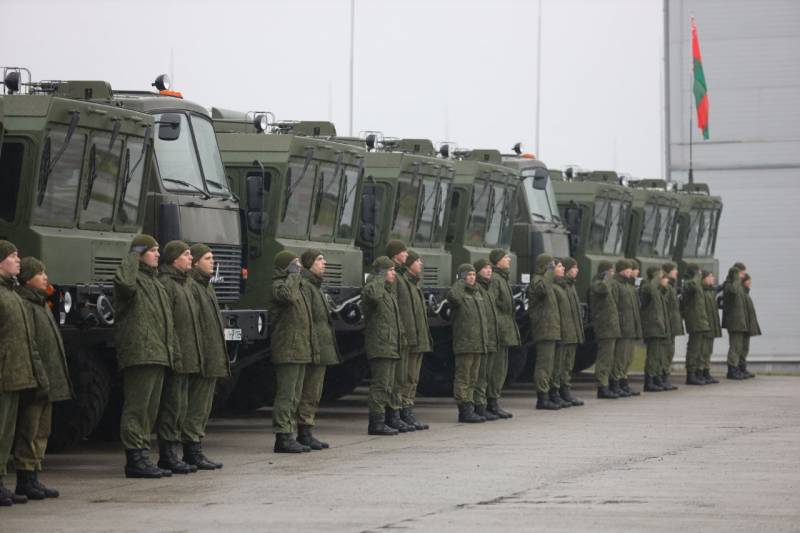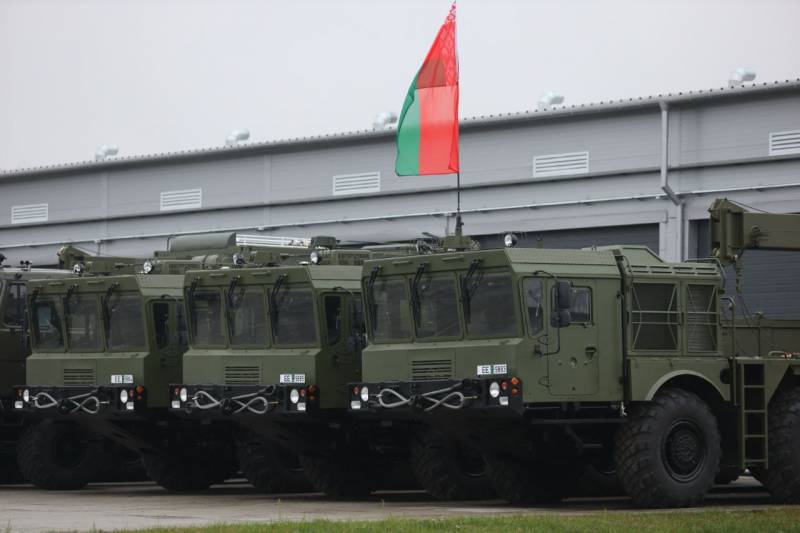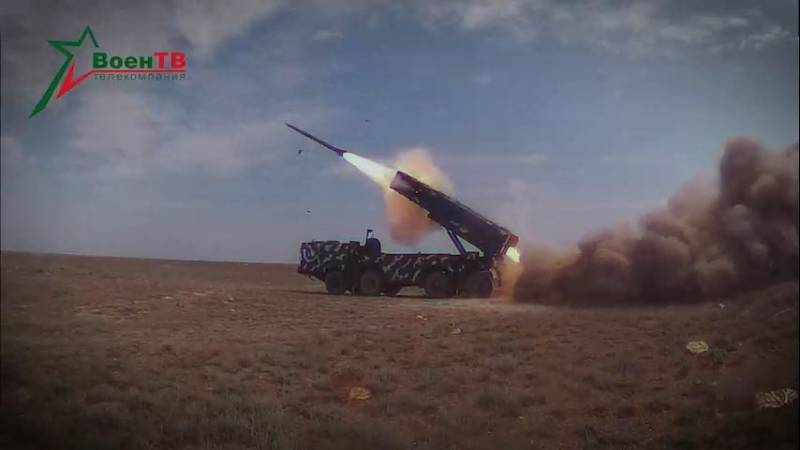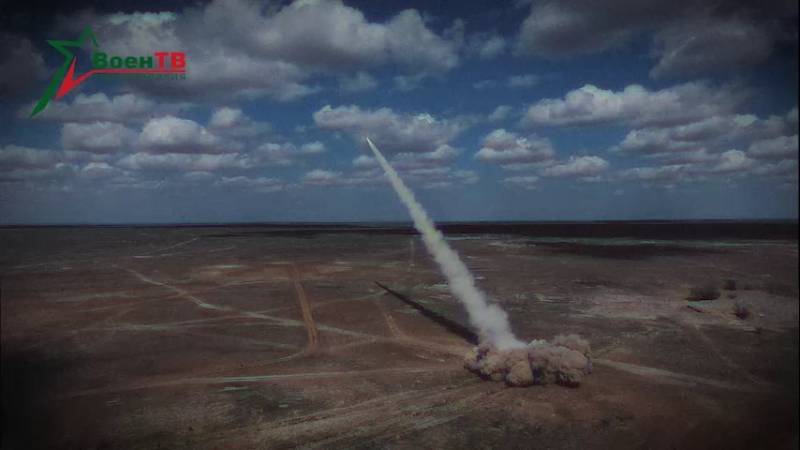The Belarusian army received the Polonez-M MLRS

Ceremony of handing over the Polonez-M to the combat unit, November 15, 2023
The Rocket Forces of the Armed Forces of the Republic of Belarus are adopting the new B-300 Polonez-M multiple launch rocket system. It is a modernized version of the already well-known Polonaise system and is distinguished by increased tactical and technical characteristics. Thus, thanks to the new missile, the maximum firing range was increased by one and a half times - up to 300 km.
Consistent development
The basic version of the B-200 Polonaise MLRS was developed in the first half of the 9s as part of Belarusian-Chinese cooperation. The finished equipment of the new type was first shown to the public on May 2015, XNUMX. In the middle of next year, the Polonaise system entered service with the ground forces, and mass production began. At the same time, production volumes were quite modest.
During the same period, plans to modernize the Polonaise became known. By updating the equipment and introducing a new missile, they were going to improve the main tactical and technical characteristics. The development of such an MLRS, also carried out with the help of China and at the expense of Chinese products, took minimal time.
The first tests of the modernized V-300 Polonez-M MLRS took place in October 2017. As part of the first test, an experienced combat vehicle launched several missiles. As the Belarusian Ministry of Defense reported, all products hit the designated targets and confirmed the calculated tactical and technical characteristics.

It should be noted that in Belarus there are no test sites that allow launching missiles over 300 km. In this regard, tests of the Polonaise-M were carried out at two test sites at once. A firing position was set up on one, and training targets were located on the second. The flight path of the missiles ran over uninhabited areas between the training grounds.
According to various sources, in the future the Belarusian industry repeatedly conducted various tests of the B-300 system and its new long-range missile. The process of developing and fine-tuning the design continued until recently and has now led to the desired result. "Polonaise-M" received a recommendation for adoption.
For unknown reasons, the process of developing and testing the Polonaise-M took longer than work on the basic B-200 product. Probably, the overall complexity of this project, as well as the features of its key element in the form of a new rocket, affected the timing. One way or another, tests of the V-300 MLRS have been completed and mass production has begun.
First in service
On November 15, the Ministry of Defense and the State Military-Industrial Commission of the Republic of Belarus announced the start of deliveries of the new MLRS to the troops. The first divisional set of the Polonez-M system was solemnly handed over to the 336th rocket artillery brigade (Osipovichi). This formation is already armed with the basic version of the Polonaise, and is now being reinforced with long-range systems.

The Ministry of Defense and the military-industrial complex do not specify the quantity of equipment supplied. At the same time, photographs and videos from the solemn ceremony of transfer of equipment were published. The footage captured nine vehicles on a special four-axle MZKT chassis, probably launchers, as well as several auxiliary trucks. The new division probably includes three batteries of three combat vehicles each.
Further plans of the defense department and industry are unknown. Perhaps the production of Polonez-M will continue. In addition, troops should receive significant stocks of compatible missiles. However, the possibility of recurrence cannot be ruled out. stories with Polonaise products, which were not mass-produced, but were still able to positively influence the combat effectiveness of the missile forces.
Technical features
The B-300 Polonez-M is a self-propelled multiple launch rocket system with improved tactical and technical characteristics. Due to a number of features and a new missile, such a MLRS is capable of solving quite complex problems over an extended range. At the same time, the MLRS gets the opportunity to compete with full-fledged operational-tactical missile systems.
The system includes several main components. This is a self-propelled launcher, missiles of at least two types, a transport-loading vehicle and a combat control vehicle. A complex of this composition can move along roads and off-roads, reach specified positions and quickly prepare to fire, and then leave the position in the minimum amount of time.

Combat vehicle crew at work
The combat vehicles of the two Polonaises are built on a four-axle all-wheel drive MZKT-7930 Astrologer chassis. The cockpit of such a vehicle houses the combat crew and control equipment. A launcher for eight transport and launch containers is mounted in the stern. Horizontal and vertical guidance within large sectors is provided. The launcher is reloaded by removing empty TPKs and installing new ones.
The fire control system includes satellite navigation, a computer for calculations, data input devices into missile equipment, remote control of the launcher, etc. Probably, the control systems of the two Polonaises are similar, and the main differences are related to the introduction of a long-range missile in the new project.
The first version of the Polonaise used the B-200 guided missile. According to known data, this was a Belarusian licensed version of the Chinese product A200, developed by the CALT Academy. This is a 301 mm caliber rocket, 7,26 m long and weighing 750 kg. It is equipped with a solid propellant engine providing a flight range of up to 200 km, and carries one of three types of warhead. Control along the trajectory is carried out using satellite navigation devices and aerodynamic rudders. The CEP does not exceed tens of meters.
The new B300 rocket for Polonaise-M is also believed to have Chinese roots. This may be a licensed version of the A300 or M20 product from the same CALT Academy. These missiles have dimensions at the A200 level, but are capable of flying at a range of up to 280-300 km. Guidance with an accuracy of tens of meters is carried out using satellite signals.

Start of a rocket
Self-propelled launchers are serviced by standard transport-loading vehicles. Such a product is built on a wheeled chassis with suitable characteristics and carries an additional eight TPK with missiles. To load them onto the combat vehicle, it has its own crane.
The work of the unit is controlled by the combat control machine. It carries a KUNG with various equipment and crew positions. Determination of own coordinates, reception and processing of target data, as well as subsequent issuance of target designation to combat vehicles are provided.
Potential growth
The Belarusian army and defense industry, using all available opportunities, continue to develop their rocket artillery. Previously, a new long-range MLRS was created and mass-produced, and now its improved version, characterized by a significant increase in key characteristics, is entering service.
The Polonaise-M project, like the basic B-200, shows the ability of the Belarusian industry to develop and produce rocket artillery. To develop such production, she had to turn to China for help, and it provided the necessary documentation, technology, etc. Production has been successfully mastered, which should benefit Belarusian enterprises.

However, the main results of the Polonaise-M project are in the development of rocket artillery. The firing range was increased from 200 to 300 km, which dramatically increased the potential of the system. At the same time, as in the case of the basic Polonaise, the MLRS can be compared in its main characteristics with some operational-tactical missile systems.
As a result, the Belarusian army now has two long-range missile systems capable of hitting targets at distances of up to 300 km - the Russian Iskander and the Belarusian-Chinese Polonaise-M. Both products have their own advantages and strengths, the proper use of which increases the flexibility of the missile forces, and should also have a positive impact on the effectiveness of their operation and combat use.
Positive results
Thus, the Belarusian army, at the expense of foreign assistance, is carrying out a consistent and major modernization of its missile forces and rocket artillery. The most effective models with high characteristics are entering service, giving the army completely new combat capabilities.
To date, the Belarusian army has received several divisions of the Polonaise MLRS of two versions and a certain number of Russian Iskanders. In addition, MLRS and fuel dispensers of older models remain in service. It can be assumed that missile forces with such equipment, despite its limited quantity, are capable of solving the problems of deterrence in peacetime and defeating the enemy in wartime with the required results.
Information